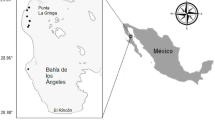Abstract
Skin and blubber samples of ten adult male Pacific walruses (Odobenus rosmarus divergens) from Alaska were used to investigate the relationship between organochlorine (OC) levels in skin and blubber of individuals. For analyses we selected 11 components that were quantified in the blubber of all individuals: hexachlorocyclohexanes (αHCH and βHCH), the DDT (dichlorodiphenyltrichloroethane) metabolite p,p′DDE, oxychlordane, and 7 individual PCB congeners, 28, 99, 105, 118, 138, 153 and 180. The correlation between the levels in the two types of tissues was significant and the relation was isometric for all components. The regression coefficient between levels in blubber (dependent variable) and levels in skin (independent variable) was different from 1 for only four of the components. The mean levels in the two types of tissues were significantly different for 3 of the 11 chemical components (βHCH, oxychlordane, and PCB28). Although this analysis is based on only ten individuals, we propose that skin samples taken by biopsy darts can be used to monitor OC levels in walruses. In August 1993 skin biopsies were collected from 25 adult male Atlantic walruses (O. r. rosmarus) at haul-out sites in southeastern Svalbard in the Norwegian Arctic and from 28 walruses of different sex and age at haul-out sites at Franz Josef Land in the Russian Arctic. The mean levels of OCs were 2–10 times higher at Svalbard than at Franz Josef Land. The dominant OC component was PCB153 in both areas. A principal component analysis detected differences between areas in OC levels but not in patterns. Since the Franz Josef Land samples were mainly taken from females and young individuals and the Svalbard samples were taken largely from adult males, we believe the differences in tissue OC levels observed from these areas can be explained by differences in sex and age of the walrus sampled. Comparable organochlorine levels in skin samples from walruses from other areas are not available. However, compared to the corresponding OC levels found in walrus blubber in other areas, the OC levels from Svalbard and Franz Josef Land are higher. The high levels of OCs in walruses from Svalbard and Franz Josef Land may be a combined effect of high pollution level in the environment and seal-eating habits. In the present study we show that it is possible to use skin biopsies taken by a non-destructive method to assess OC levels in walruses.
Similar content being viewed by others
Author information
Authors and Affiliations
Additional information
Accepted: 24 October 1999
Rights and permissions
About this article
Cite this article
Wiig, Ø., Berg, V., Gjertz, I. et al. Use of skin biopsies for assessing levels of organochlorines in walruses (Odobenus rosmarus). Polar Biol 23, 272–278 (2000). https://doi.org/10.1007/s003000050444
Issue Date:
DOI: https://doi.org/10.1007/s003000050444




